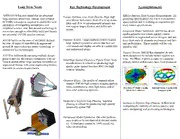
NASA Technical Reports Server (NTRS) 20140004079: Advanced UVOIR Mirror Technology Development (AMTD) for Very Large Space Telescopes PDF
Preview NASA Technical Reports Server (NTRS) 20140004079: Advanced UVOIR Mirror Technology Development (AMTD) for Very Large Space Telescopes
Long Term Needs Key Technology Development Accomplishments ASTRO2010 Decadal stated that an advanced AMTD derived, from Science Requirements, En- •Large-Aperture, Low Areal Density, High Stiff- large-aperture ultraviolet, optical, near-infrared gineering Specifications for 4 to 8 m monolithic ness Mirror Substrates: Both (4 to 8 m) mono- (UVOIR) telescope is required to enable the next space mirrors and is working on segmented pri- lithic and (8 to 16 m) segmented primary mir- generation of compelling astrophysics and mary mirror specifications. rors require larger, thicker, and stiffer sub- exoplanet science; and, that present technology is strates. not mature enough to affordably build and launch Integrated Model Validation: AMTD has devel- any potential UVOIR mission concept. oped a powerful tool which quickly creates monolithic or segmented mirror designs; and ana- AMTD builds on the state of art (SOA) defined •Support System: Large-aperture mirrors require lyzes their static & dynamic mechanical and ther- by over 30 years of monolithic & segmented large support systems to ensure that they sur- mal performance. These models will be vali- ground & space-telescope mirror technology to vive launch and deploy on orbit in a stress-free dated by test. mature six key technologies. and undistorted shape. Support System: AMTD has expanded its sub- AMTD is deliberately pursuing multiple design strate design tool to include launch support sys- paths to provide the science community with op- tems. Pre-Phase-A point designs for candidate •Mid/High Spatial Frequency Figure Error: Very tions to enable either large aperture monolithic or primary mirror architectures have been produced. smooth mirror is critical for producing high- segmented mirrors with clear engineering metrics quality point spread function (PSF) for high traceable to science requirements. contrast imaging. •Segment Edges: The quality of segment edges impacts PSF for high-contrast imaging applica- tions, contributes to stray light noise, and af- Free-Free 1st Mode: 4 m dia Internal Stress: 4 m dia with fects total collecting aperture. 40 cm thick substrate 6 support pads •Segment to Segment Gap Phasing: Segment Segment to Segment Gap Phasing: AMTD is in- phasing is critical for producing high-quality vestigating the viability of various passive and temporally-stable PSF. active dampening and positioning technologies. •Integrated Model Validation: On-orbit perform- ance is driven by mechanical & thermal stabil- ity. Compliance cannot be 100% tested, but relies on modeling. Accomplishments (cont.) Accomplishments (cont.) Advanced UVOIR Mirror Technology Development Large-Aperture, Low Areal Density, High Stiff- Mid/High Spatial Frequency Figure Error: AMTD ness Mirror Substrates: AMTD partner Exelis partner Exelis polished the 40 cm mirror to a zero- (AMTD) for Very Large developed & demonstrated a technique to manu- gravity figure of 5.5 nm rms. MSFC tested 43 cm facture a 400 mm thick substrate via ‘stacking mirror from 250 to 300K. Its thermal deformation Space Telescopes and fusing’ three core structural elements to front was insignificant (smaller than 4 nm rms shape and back faceplates; making a 40 cm ‘cut-out’ of change). a 4 meter diameter 60 kg/m2 mirror. This new process offers a lower cost approach for manu- facturing Phase II Award large- diameter Plan to build subscale 1.3m-1.5m Pathfinder mir- high- ror using same processes and techniques developed stiffness under Phase I. mirrors. Core Segments Post-Fusion: 3 Core Post Slump: 2.5 m Layers & Vent Hole Radius of Curvature Pathfinder mirror Visible will be stacked core with pocket AMTD is a multiyear effort to Demo mirror milled face plates in V-block like the Phase I develop, demonstrate and mature mount and the resulting Demo mirror multiple ori- critical technologies to TRL-6 by entation 2018 so that a viable flight mis- 5.5nm rms surface. sion can be proposed to the 2020 Decadal. Science Advisory Team: Dr. Marc Postman, STScI Segment Edges: AMTD Partner STScI demon- Dr. Remi Soummer, STScI strated a microdot apodization technique to miti- Dr. Annand Sivramakrishnan, STScI gate edge diffraction effects for high contrast im- Dr. Bruce Macintosh, LLNL Dr. Olivier Guyon, UoA Systems Engineering Team Dr. H. Philip Stahl, NASA Dr. W. Scott Smith, NASA Dr. Gary Mosier, NASA Laura Abplanalp, Exelis William Arnold, DAI/Jacobs Microdot attenuation is achromatic & linear with density
